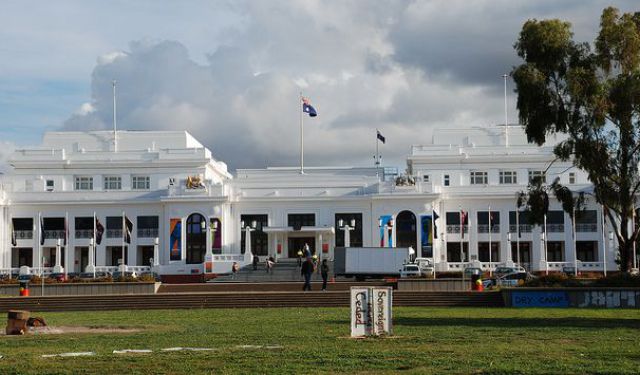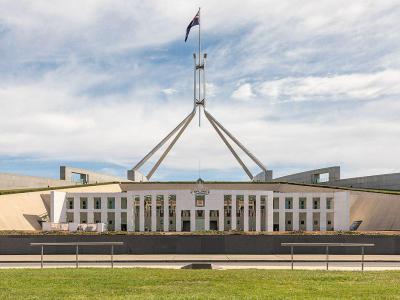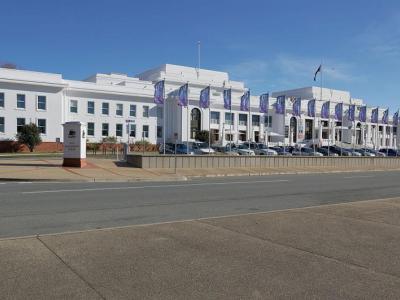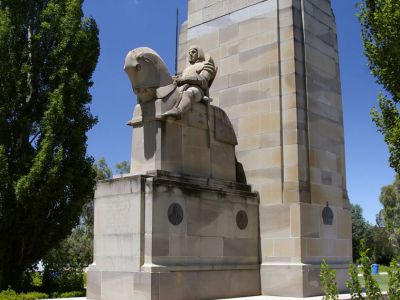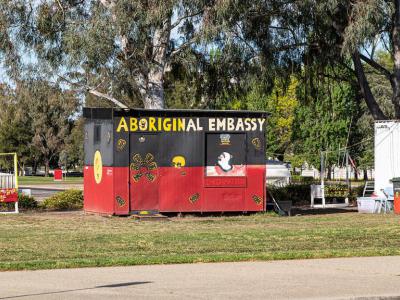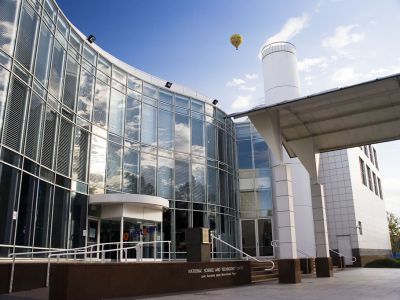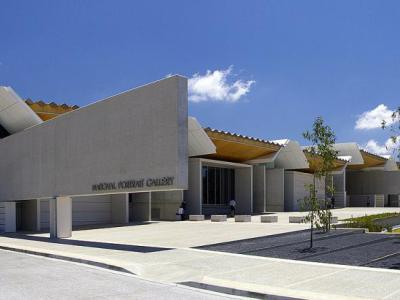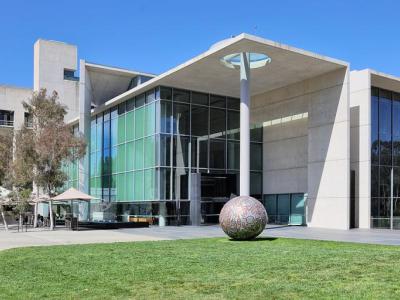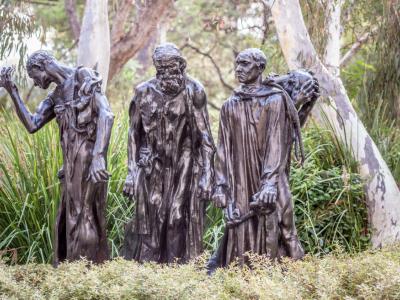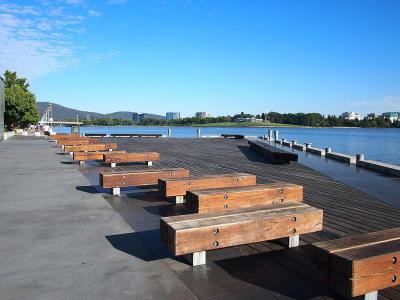Canberra Downtown Walking Tour (Self Guided), Canberra
Australia’s capital, Canberra, is jokingly nicknamed the "Bush Capital” for the abundance of forested and natural reserve lands around. What's now the Australian Capital Territory previously has been inhabited by Aboriginal people for more than 20,000 years.
The name "Canberra" originates from the Aboriginal Australian language and means a "meeting place". European settlement of the area commenced in the first half of the 19th century. Following a long dispute between rivals Sydney and Melbourne, Canberra was chosen to be the nation's capital, as a compromise, in 1913.
Unusual for Australian cities, Canberra is entirely planned. Its design was masterminded by American architects Walter Burley Griffin and Marion Mahony Griffin, whose vision implied geometric motifs and was centered on axes aligned with significant topographical landmarks such as Black Mountain, Mount Ainslie, Capital Hill, and City Hill.
Its center-most piece – Lake Burley Griffin – is dotted with sailboats and kayaks. Overlooking the lake from atop Capital Hill is the massive Parliament House, an architectural marvel and the seat of the nation's legislature. A stark contrast to this modern structure is the Old Parliament House nearby, which now houses the Museum of Australian Democracy. Surrounding the Old Parliament House are the meticulously maintained Old Parliament House Gardens, offering a serene escape with beautifully landscaped paths and seasonal flowers.
Close to this verdant area stands the King George V Memorial, dedicated to the monarch who reigned at the time of Canberra’s naming.
This planned city is also famous for its wide boulevards, large public spaces, and rings of parklands. Among these, the downtown area stands out, showcasing landmarks that narrate the unfolding story of Australia’s statehood journey.
A poignant counterpoint to the grand national symbols is the Aboriginal Tent Embassy. Set up in 1972, this protest site represents the ongoing struggle of Indigenous Australians for land rights and justice, highlighting Canberra’s role as a stage for significant civil rights dialogues. Also notable in this respect is the National Gallery of Australia, showcasing Indigenous art collections.
For science enthusiasts, Questacon provides a hands-on experience with its engaging science exhibits, making it a favorite among families.
Commonwealth Place, a hub along the scenic Lake Burley Griffin, offers a waterfront promenade lined with activities and eateries, encapsulating the lively public life of Canberra.
For those looking to understand Australia beyond its scenic landscapes, Canberra’s cultural and historical sites provide a comprehensive overview of the nation's heritage and its ongoing narrative. If you're keen to delve into its unique offerings, Canberra invites you to explore and engage with Australia’s story.
The name "Canberra" originates from the Aboriginal Australian language and means a "meeting place". European settlement of the area commenced in the first half of the 19th century. Following a long dispute between rivals Sydney and Melbourne, Canberra was chosen to be the nation's capital, as a compromise, in 1913.
Unusual for Australian cities, Canberra is entirely planned. Its design was masterminded by American architects Walter Burley Griffin and Marion Mahony Griffin, whose vision implied geometric motifs and was centered on axes aligned with significant topographical landmarks such as Black Mountain, Mount Ainslie, Capital Hill, and City Hill.
Its center-most piece – Lake Burley Griffin – is dotted with sailboats and kayaks. Overlooking the lake from atop Capital Hill is the massive Parliament House, an architectural marvel and the seat of the nation's legislature. A stark contrast to this modern structure is the Old Parliament House nearby, which now houses the Museum of Australian Democracy. Surrounding the Old Parliament House are the meticulously maintained Old Parliament House Gardens, offering a serene escape with beautifully landscaped paths and seasonal flowers.
Close to this verdant area stands the King George V Memorial, dedicated to the monarch who reigned at the time of Canberra’s naming.
This planned city is also famous for its wide boulevards, large public spaces, and rings of parklands. Among these, the downtown area stands out, showcasing landmarks that narrate the unfolding story of Australia’s statehood journey.
A poignant counterpoint to the grand national symbols is the Aboriginal Tent Embassy. Set up in 1972, this protest site represents the ongoing struggle of Indigenous Australians for land rights and justice, highlighting Canberra’s role as a stage for significant civil rights dialogues. Also notable in this respect is the National Gallery of Australia, showcasing Indigenous art collections.
For science enthusiasts, Questacon provides a hands-on experience with its engaging science exhibits, making it a favorite among families.
Commonwealth Place, a hub along the scenic Lake Burley Griffin, offers a waterfront promenade lined with activities and eateries, encapsulating the lively public life of Canberra.
For those looking to understand Australia beyond its scenic landscapes, Canberra’s cultural and historical sites provide a comprehensive overview of the nation's heritage and its ongoing narrative. If you're keen to delve into its unique offerings, Canberra invites you to explore and engage with Australia’s story.
How it works: Download the app "GPSmyCity: Walks in 1K+ Cities" from Apple App Store or Google Play Store to your mobile phone or tablet. The app turns your mobile device into a personal tour guide and its built-in GPS navigation functions guide you from one tour stop to next. The app works offline, so no data plan is needed when traveling abroad.
Canberra Downtown Walking Tour Map
Guide Name: Canberra Downtown Walking Tour
Guide Location: Australia » Canberra (See other walking tours in Canberra)
Guide Type: Self-guided Walking Tour (Sightseeing)
# of Attractions: 10
Tour Duration: 2 Hour(s)
Travel Distance: 2.6 Km or 1.6 Miles
Author: DanaOffice
Sight(s) Featured in This Guide:
Guide Location: Australia » Canberra (See other walking tours in Canberra)
Guide Type: Self-guided Walking Tour (Sightseeing)
# of Attractions: 10
Tour Duration: 2 Hour(s)
Travel Distance: 2.6 Km or 1.6 Miles
Author: DanaOffice
Sight(s) Featured in This Guide:
- Parliament House
- Old Parliament House Gardens
- Museum of Australian Democracy at Old Parliament House
- King George V Memorial
- Aboriginal Tent Embassy
- Questacon
- National Portrait Gallery
- National Gallery of Australia
- Sculpture Garden
- Commonwealth Place
1) Parliament House (must see)
Parliament House is a striking symbol of the nation’s democratic process and architectural innovation. Officially opened on 9 May 1988 by Queen Elizabeth II, the building was the most expensive in the world at the time, with construction costs exceeding A$1.1 billion. Designed by Mitchell/Giurgola Architects, the structure embodies a unique architectural concept inspired by the shape of two boomerangs, a nod to Australia's indigenous heritage. It features a prominent 81-meter flagpole that crowns the building, symbolizing national pride and unity.
The design of Parliament House incorporates over 4,700 rooms, many of which are accessible to the public. The interior is a blend of grand spaces and functional areas, reflecting both the ceremonial and operational aspects of Australian governance. The main foyer is adorned with a marble staircase leading to the Great Hall, where visitors can admire a large, intricately woven tapestry. The House of Representatives chamber is distinguished by its green decor, while the Senate chamber features a rich red color scheme, each representing the traditional colors of Australian parliamentary practice.
Between the two chambers lies the Members' Hall, which includes a tranquil water feature but is restricted from public access. The Ministerial Wing, housing the offices of the Prime Minister and other key ministers, underscores the building’s role as the epicenter of Australian political life. This wing, along with other sections of Parliament House, exemplifies the blend of modern functionality with symbolic design.
As the permanent seat of Australia's federal government, Parliament House not only serves as a functional workspace but also as a landmark of national significance and architectural excellence.
The design of Parliament House incorporates over 4,700 rooms, many of which are accessible to the public. The interior is a blend of grand spaces and functional areas, reflecting both the ceremonial and operational aspects of Australian governance. The main foyer is adorned with a marble staircase leading to the Great Hall, where visitors can admire a large, intricately woven tapestry. The House of Representatives chamber is distinguished by its green decor, while the Senate chamber features a rich red color scheme, each representing the traditional colors of Australian parliamentary practice.
Between the two chambers lies the Members' Hall, which includes a tranquil water feature but is restricted from public access. The Ministerial Wing, housing the offices of the Prime Minister and other key ministers, underscores the building’s role as the epicenter of Australian political life. This wing, along with other sections of Parliament House, exemplifies the blend of modern functionality with symbolic design.
As the permanent seat of Australia's federal government, Parliament House not only serves as a functional workspace but also as a landmark of national significance and architectural excellence.
2) Old Parliament House Gardens
The Old Parliament House Gardens offer a serene escape adorned with vibrant rose-filled landscapes. The gardens are divided into two distinct areas: the House of Representatives Garden and the Senate Garden, each located on either side of Old Parliament House. These gardens were originally established during the Great Depression, and when the Parliament moved to its new location on Capital Hill in 1988, the gardens were opened to the public.
The transformation of these gardens began in earnest during the tenure of Robert Broinowski, Secretary of the Joint House Department, who, between 1931 and 1938, developed the gardens into an oasis of beauty and functionality. Initially, the landscape was sparse, but under Broinowski’s guidance and with support from the National Rose Society of New South Wales, the gardens were meticulously planned and planted. The addition of hedges to shield against the wind, tennis courts, a cricket pitch, and bowling green, along with four rose gardens, made the space both practical and aesthetically pleasing for members and staff.
However, the gardens fell into neglect following the opening of the new Parliament House, with their floral displays reduced and the tennis courts left locked. The revitalization of the Old Parliament House Gardens began in 2000, focusing on restoring the gardens to their former glory. This included replanting hedges, reconstructing the four rose gardens, and adding paths and public facilities. The restoration efforts aimed to preserve the original design and enhance the gardens' historic and cultural significance.
Today, the Old Parliament House Gardens are a popular venue for both public and corporate functions. The introduction of new features such as seating pavilions, pergolas, and rose arbours has further enriched the gardens, making them a delightful destination for visitors. The careful restoration has ensured that these gardens remain a lush, vibrant tribute to Australia’s parliamentary heritage.
The transformation of these gardens began in earnest during the tenure of Robert Broinowski, Secretary of the Joint House Department, who, between 1931 and 1938, developed the gardens into an oasis of beauty and functionality. Initially, the landscape was sparse, but under Broinowski’s guidance and with support from the National Rose Society of New South Wales, the gardens were meticulously planned and planted. The addition of hedges to shield against the wind, tennis courts, a cricket pitch, and bowling green, along with four rose gardens, made the space both practical and aesthetically pleasing for members and staff.
However, the gardens fell into neglect following the opening of the new Parliament House, with their floral displays reduced and the tennis courts left locked. The revitalization of the Old Parliament House Gardens began in 2000, focusing on restoring the gardens to their former glory. This included replanting hedges, reconstructing the four rose gardens, and adding paths and public facilities. The restoration efforts aimed to preserve the original design and enhance the gardens' historic and cultural significance.
Today, the Old Parliament House Gardens are a popular venue for both public and corporate functions. The introduction of new features such as seating pavilions, pergolas, and rose arbours has further enriched the gardens, making them a delightful destination for visitors. The careful restoration has ensured that these gardens remain a lush, vibrant tribute to Australia’s parliamentary heritage.
3) Museum of Australian Democracy at Old Parliament House (must see)
The Museum of Australian Democracy at Old Parliament House offers a deep dive into the nation’s social and political history within a historically rich setting. This living museum is housed in the building that served as the Parliament of Australia from 1927 to 1988, before the seat of government moved to the new Parliament House on Capital Hill. The building, originally known as the Provisional Parliament House, was designed by architect John Smith Murdoch in a Simplified Classical Style, eschewing traditional classical elements for a more orderly and symmetrical approach.
Visitors to the museum can explore various historic spaces, including the former Prime Minister’s Office, the Press Room, and the House of Representatives. These areas provide a window into the political workings and daily operations of the Australian government during the building’s operational years. The museum also features a range of dynamic exhibitions, offering insights into both past and present social and political issues, as well as glimpses into future developments.
In addition to its permanent exhibitions, the Museum of Australian Democracy hosts temporary exhibitions, lectures, and concerts, enhancing its role as a vibrant cultural and educational venue. The museum’s extensive collections and interactive exhibits are designed to engage visitors and foster a deeper understanding of Australia’s democratic processes and historical evolution.
Since its rebranding in 2009, the museum has continued to build on its mission of interpreting Australia’s political and social landscape, ensuring that the Old Parliament House remains a significant site of national historical importance.
Visitors to the museum can explore various historic spaces, including the former Prime Minister’s Office, the Press Room, and the House of Representatives. These areas provide a window into the political workings and daily operations of the Australian government during the building’s operational years. The museum also features a range of dynamic exhibitions, offering insights into both past and present social and political issues, as well as glimpses into future developments.
In addition to its permanent exhibitions, the Museum of Australian Democracy hosts temporary exhibitions, lectures, and concerts, enhancing its role as a vibrant cultural and educational venue. The museum’s extensive collections and interactive exhibits are designed to engage visitors and foster a deeper understanding of Australia’s democratic processes and historical evolution.
Since its rebranding in 2009, the museum has continued to build on its mission of interpreting Australia’s political and social landscape, ensuring that the Old Parliament House remains a significant site of national historical importance.
4) King George V Memorial
The King George V Memorial, situated near Old Parliament House, is a significant tribute to the leadership of King George V during World War I. Erected in 1953, the memorial's creation was delayed from its original commission in 1936 due to the disruptions of the Second World War. Initially placed directly in front of Parliament House, the memorial was later relocated in 1968 to its current position, which was preferred by the sculptor Raynor Hoff and designer Harry Foskett.
The memorial features a prominent bronze statue of King George V, flanked by a granite pylon. On the opposite side of the pylon stands a stone statue of Saint George, symbolizing the king's role in leading Britain through the First World War. The base of the memorial is adorned with medallions representing key figures of the era: a nurse, a soldier, an airman, and a sailor, all of whom embody the wartime contributions of various service members.
Additionally, the memorial reflects historical ties with Australia through depictions of George V and his wife as they appeared during their visit to Australia in 1901, alongside key figures of the Australian Federation such as Henry Parkes, Samuel Griffith, and Edmund Barton. The imperial crown further connects the memorial to the broader context of the British Empire and its influence on Australian history.
The memorial features a prominent bronze statue of King George V, flanked by a granite pylon. On the opposite side of the pylon stands a stone statue of Saint George, symbolizing the king's role in leading Britain through the First World War. The base of the memorial is adorned with medallions representing key figures of the era: a nurse, a soldier, an airman, and a sailor, all of whom embody the wartime contributions of various service members.
Additionally, the memorial reflects historical ties with Australia through depictions of George V and his wife as they appeared during their visit to Australia in 1901, alongside key figures of the Australian Federation such as Henry Parkes, Samuel Griffith, and Edmund Barton. The imperial crown further connects the memorial to the broader context of the British Empire and its influence on Australian history.
5) Aboriginal Tent Embassy
The Aboriginal Tent Embassy, located on the lawns of Old Parliament House, stands as a powerful symbol of the ongoing struggle for Aboriginal rights in Australia. Established in 1972, it emerged as a bold and unconventional protest against the lack of political recognition and legal rights for Australia's Indigenous peoples. Despite not being officially recognized as an embassy by the Australian government, the Tent Embassy serves as a focal point for advocating Aboriginal sovereignty and addressing issues such as land rights, mineral rights, and compensation for historically dispossessed lands.
The Embassy is characterized by its semi-permanent setup of tents and signs, reflecting its role as a grassroots movement rather than a formal diplomatic mission. The activists involved in the Embassy argue for a range of demands, including the return of sacred sites and better legal protections for Indigenous lands. Their calls for justice and acknowledgment have faced significant resistance from successive governments, but the Embassy remains a persistent voice in the ongoing dialogue about Aboriginal rights.
In addition to its historical and political significance, the Aboriginal Tent Embassy is also a site of cultural and community expression. It provides a space for Indigenous Australians to gather, organize, and voice their concerns on issues affecting their communities. Elders and activists continue to use the Embassy as a platform for addressing contemporary challenges, such as the protection of traditional lands from mining and other forms of exploitation.
The Embassy is characterized by its semi-permanent setup of tents and signs, reflecting its role as a grassroots movement rather than a formal diplomatic mission. The activists involved in the Embassy argue for a range of demands, including the return of sacred sites and better legal protections for Indigenous lands. Their calls for justice and acknowledgment have faced significant resistance from successive governments, but the Embassy remains a persistent voice in the ongoing dialogue about Aboriginal rights.
In addition to its historical and political significance, the Aboriginal Tent Embassy is also a site of cultural and community expression. It provides a space for Indigenous Australians to gather, organize, and voice their concerns on issues affecting their communities. Elders and activists continue to use the Embassy as a platform for addressing contemporary challenges, such as the protection of traditional lands from mining and other forms of exploitation.
6) Questacon (must see)
Questacon – the National Science and Technology Centre – is a prominent educational attraction situated on the southern shore of Lake Burley Griffin in Canberra. Since its opening in 1988, Questacon has been a pioneering venue for interactive science education in Australia, featuring over 200 hands-on exhibits that explore a wide range of scientific and technological concepts. Originally opened at Ainslie Primary School, the centre quickly gained recognition for its innovative approach to science communication and was the first interactive science center in the country.
The design of Questacon is notable for its spiral ramp, which encircles the central "drum" of the building and provides access to seven distinct galleries. Each gallery focuses on different aspects of science and technology, allowing visitors to engage with exhibits that range from physics and engineering to biology and environmental science. This layout not only enhances the visitor experience but also ensures that there is something of interest for people of all ages.
Among its many features, Questacon boasts a well-stocked shop offering educational science toys, books, and resources for teachers, further extending its educational mission. The on-site café, located in the building's foyer, provides a convenient spot for visitors to relax and refresh during their exploration of the exhibits.
The design of Questacon is notable for its spiral ramp, which encircles the central "drum" of the building and provides access to seven distinct galleries. Each gallery focuses on different aspects of science and technology, allowing visitors to engage with exhibits that range from physics and engineering to biology and environmental science. This layout not only enhances the visitor experience but also ensures that there is something of interest for people of all ages.
Among its many features, Questacon boasts a well-stocked shop offering educational science toys, books, and resources for teachers, further extending its educational mission. The on-site café, located in the building's foyer, provides a convenient spot for visitors to relax and refresh during their exploration of the exhibits.
7) National Portrait Gallery
The National Portrait Gallery of Australia serves as a dedicated space for showcasing the lives and achievements of prominent Australians. Officially opening its doors on 4 December 2008, the gallery's permanent home stands adjacent to the High Court of Australia, forming part of the architectural and cultural hub known as the Parliamentary Triangle. The building itself is a modern structure, characterized by its use of concrete and timber, which complements its role as a contemporary institution dedicated to portraiture.
Founded in May 1998, the gallery initially occupied space in Old Parliament House and a nearby gallery on Commonwealth Place. During these early years, the collection was notable for its focus on contemporary portraits, particularly through photography. The move to its current location allowed for an expanded and more permanent display of portraits that celebrate individuals whose contributions have made significant impacts in their respective fields or who hold long-term public interest.
The National Portrait Gallery's collection is curated to highlight Australians who have made noteworthy contributions to various spheres of life, from politics and arts to science and sports. Each portrait serves not just as a depiction of the individual, but as a narrative of their influence and legacy. The gallery's mission is to offer insight into the lives of these distinguished figures, allowing visitors to explore the stories behind the faces that have shaped Australia’s history and culture.
The transition to the purpose-built facility in 2008 marked a significant milestone for the gallery, providing a fitting backdrop for the evolving collection.
Founded in May 1998, the gallery initially occupied space in Old Parliament House and a nearby gallery on Commonwealth Place. During these early years, the collection was notable for its focus on contemporary portraits, particularly through photography. The move to its current location allowed for an expanded and more permanent display of portraits that celebrate individuals whose contributions have made significant impacts in their respective fields or who hold long-term public interest.
The National Portrait Gallery's collection is curated to highlight Australians who have made noteworthy contributions to various spheres of life, from politics and arts to science and sports. Each portrait serves not just as a depiction of the individual, but as a narrative of their influence and legacy. The gallery's mission is to offer insight into the lives of these distinguished figures, allowing visitors to explore the stories behind the faces that have shaped Australia’s history and culture.
The transition to the purpose-built facility in 2008 marked a significant milestone for the gallery, providing a fitting backdrop for the evolving collection.
8) National Gallery of Australia
The National Gallery of Australia in Canberra stands as the country’s premier visual arts institution, offering visitors a rich encounter with creativity from Australia and around the world. Established in 1982, the gallery was built to house the national art collection, which has since grown into one of the most significant in the Southern Hemisphere. Its striking modernist architecture, designed by Colin Madigan, makes the building itself a landmark, set against the backdrop of landscaped sculpture gardens along the shores of Lake Burley Griffin.
Inside, the gallery’s vast holdings showcase more than 155,000 works across multiple disciplines. Visitors can explore Australian art in depth, from colonial landscapes and contemporary pieces to an outstanding collection of Indigenous art, widely regarded as one of the most comprehensive in existence. Equally impressive are the international holdings, which include notable works of European, Asian, and American art, ensuring that guests experience a wide-reaching perspective on visual culture.
One of the gallery’s most celebrated spaces is its Aboriginal and Torres Strait Islander art collection, featuring vibrant bark paintings, dot paintings, and sculptures that reflect ancient traditions and modern expressions. Beyond this, highlights include works by masters such as Jackson Pollock, Claude Monet, and Andy Warhol, offering a global dialogue between traditions and movements. Temporary exhibitions, often drawn from prestigious institutions worldwide, keep the program dynamic and engaging.
The outdoor sculpture garden provides another dimension, with iconic works displayed among native plantings, creating a contemplative atmosphere. Whether for its permanent collection, international exhibitions, or architectural setting, the National Gallery of Australia offers a compelling destination for art lovers and casual visitors alike.
Inside, the gallery’s vast holdings showcase more than 155,000 works across multiple disciplines. Visitors can explore Australian art in depth, from colonial landscapes and contemporary pieces to an outstanding collection of Indigenous art, widely regarded as one of the most comprehensive in existence. Equally impressive are the international holdings, which include notable works of European, Asian, and American art, ensuring that guests experience a wide-reaching perspective on visual culture.
One of the gallery’s most celebrated spaces is its Aboriginal and Torres Strait Islander art collection, featuring vibrant bark paintings, dot paintings, and sculptures that reflect ancient traditions and modern expressions. Beyond this, highlights include works by masters such as Jackson Pollock, Claude Monet, and Andy Warhol, offering a global dialogue between traditions and movements. Temporary exhibitions, often drawn from prestigious institutions worldwide, keep the program dynamic and engaging.
The outdoor sculpture garden provides another dimension, with iconic works displayed among native plantings, creating a contemplative atmosphere. Whether for its permanent collection, international exhibitions, or architectural setting, the National Gallery of Australia offers a compelling destination for art lovers and casual visitors alike.
9) Sculpture Garden
The Sculpture Garden, located between the National Gallery and the shores of Lake Burley Griffin in Canberra, offers a captivating display of the Gallery’s extensive sculpture collection. Designed by Harry Howard and Associates with input from James Mollison, the Gallery’s first Director, the garden’s layout was carefully planned to harmonize with the architectural form of the National Gallery. Earthworks and plantings for the garden began in 1981, and its design incorporates a diagonal pathway that mirrors the triangular architecture of the Gallery building.
This innovative landscape design features a series of 'outside rooms' that showcase a diverse collection of 26 sculptures by both international and Australian artists. The majority of these sculptures were acquired in the early 1980s and reflect the abstract and industrial styles prevalent at the time. Noteworthy pieces include Fujiko Nakaya’s fog sculpture and the evocative Pukamani burial poles, which add a layer of cultural and artistic depth to the garden. A significant addition in 2010 is Antony Gormley’s life-sized maquette for "Angel of the North," which faces the lake and adds a striking visual element to the collection.
The garden’s plantings are carefully selected to withstand Canberra’s extreme weather conditions, including harsh winters and long, hot summers. The design is organized around the seasons, with each section reflecting a different time of year. The Winter garden, closest to the Gallery, features warm slate and winter flowering acacias, along with the earliest figurative sculptures. The Summer garden, shaded by Casuarinas and adjacent to a marsh pond, provides a cool respite during the hotter months. The Spring garden, nearer to the lake, bursts with flowering Grevilleas and Acacias. The Autumn garden, however, was never fully realized, leaving an incomplete seasonal cycle.
This innovative landscape design features a series of 'outside rooms' that showcase a diverse collection of 26 sculptures by both international and Australian artists. The majority of these sculptures were acquired in the early 1980s and reflect the abstract and industrial styles prevalent at the time. Noteworthy pieces include Fujiko Nakaya’s fog sculpture and the evocative Pukamani burial poles, which add a layer of cultural and artistic depth to the garden. A significant addition in 2010 is Antony Gormley’s life-sized maquette for "Angel of the North," which faces the lake and adds a striking visual element to the collection.
The garden’s plantings are carefully selected to withstand Canberra’s extreme weather conditions, including harsh winters and long, hot summers. The design is organized around the seasons, with each section reflecting a different time of year. The Winter garden, closest to the Gallery, features warm slate and winter flowering acacias, along with the earliest figurative sculptures. The Summer garden, shaded by Casuarinas and adjacent to a marsh pond, provides a cool respite during the hotter months. The Spring garden, nearer to the lake, bursts with flowering Grevilleas and Acacias. The Autumn garden, however, was never fully realized, leaving an incomplete seasonal cycle.
10) Commonwealth Place
Commonwealth Place, located on the southern shore of Lake Burley Griffin in Canberra’s National Triangle, is a versatile public space designed to accommodate a range of activities from major events to casual family gatherings. Spanning approximately 100 by 50 meters, the space is thoughtfully laid out with a central design that integrates seamlessly into Griffin’s Land Axis. This layout features a walkway that connects Commonwealth Place to Reconciliation Place, enhancing its accessibility and functionality.
The design of Commonwealth Place incorporates Australian sandstone for the rear wall and walkway walls, while the walkway itself is paved with Australian bluestone, creating a cohesive and locally resonant aesthetic. The space also includes undercroft areas that house a café/restaurant and office spaces, providing both convenience and vitality to the area. The addition of Speakers Square, a Centenary of Federation gift from the Canadian Government, adds a significant focal point for ceremonies and celebrations, including flag-raising events.
A notable feature of Commonwealth Place is the grove of trees planted in the shape of the Southern Cross, offering shade and adding a distinctive element to the western side of the square. The square was completed in 2002 and designed by Durbach Block Architects in collaboration with Sue Barnsley Design. It has been recognized for its architectural merit, winning the Australian Capital Territory Chapter of the Royal Australian Institute of Architects Urban Award in 2003.
The Commonwealth Place Forecourt, which was part of the initial works, enhances the recreational use of the lake by introducing a shared pedestrian zone and two jetties. These jetties, made from recycled timber and plastic, facilitate easy landing for small craft such as rowing sculls, yachts, and dinghies, promoting a greater engagement with the lake. This thoughtful design helps integrate the public space with its natural surroundings, making Commonwealth Place a key site for both community activities and individual leisure.
The design of Commonwealth Place incorporates Australian sandstone for the rear wall and walkway walls, while the walkway itself is paved with Australian bluestone, creating a cohesive and locally resonant aesthetic. The space also includes undercroft areas that house a café/restaurant and office spaces, providing both convenience and vitality to the area. The addition of Speakers Square, a Centenary of Federation gift from the Canadian Government, adds a significant focal point for ceremonies and celebrations, including flag-raising events.
A notable feature of Commonwealth Place is the grove of trees planted in the shape of the Southern Cross, offering shade and adding a distinctive element to the western side of the square. The square was completed in 2002 and designed by Durbach Block Architects in collaboration with Sue Barnsley Design. It has been recognized for its architectural merit, winning the Australian Capital Territory Chapter of the Royal Australian Institute of Architects Urban Award in 2003.
The Commonwealth Place Forecourt, which was part of the initial works, enhances the recreational use of the lake by introducing a shared pedestrian zone and two jetties. These jetties, made from recycled timber and plastic, facilitate easy landing for small craft such as rowing sculls, yachts, and dinghies, promoting a greater engagement with the lake. This thoughtful design helps integrate the public space with its natural surroundings, making Commonwealth Place a key site for both community activities and individual leisure.
Walking Tours in Canberra, Australia
Create Your Own Walk in Canberra
Creating your own self-guided walk in Canberra is easy and fun. Choose the city attractions that you want to see and a walk route map will be created just for you. You can even set your hotel as the start point of the walk.
Canberra Civic Center Walking Tour
Civic Centre, often simply called Civic, lies at the heart of Canberra, Australia's purpose-built capital. This central district is not only a hub for shopping and dining but also a significant cultural and historical site. At its core, lie an array of landmarks that tell the story of the city's past and vibrant present.
Starting with the Australian War Memorial, located at the... view more
Tour Duration: 2 Hour(s)
Travel Distance: 2.6 Km or 1.6 Miles
Starting with the Australian War Memorial, located at the... view more
Tour Duration: 2 Hour(s)
Travel Distance: 2.6 Km or 1.6 Miles
The Most Popular Cities
/ view all
